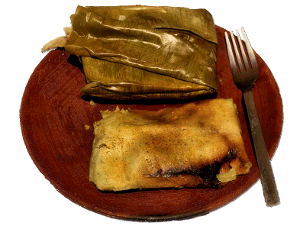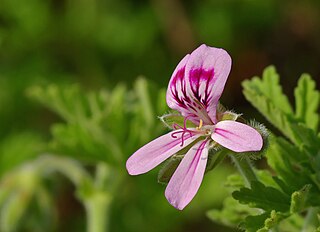Related Research Articles

A tamale, in Spanish tamal, is a traditional Mesoamerican dish made of masa, a dough made from nixtamalized corn, which is steamed in a corn husk or banana leaf. The wrapping can either be discarded prior to eating or used as a plate. Tamales can be filled with meats, cheeses, fruits, vegetables, herbs, chilies, or any preparation according to taste, and both the filling and the cooking liquid may be seasoned.

Basil (, ; Ocimum basilicum, also called great basil, is a culinary herb of the family Lamiaceae. It is a tender plant, and is used in cuisines worldwide. In Western cuisine, the generic term "basil" refers to the variety also known as sweet basil or Genovese basil. Basil is native to tropical regions from Central Africa to Southeast Asia. In temperate climates basil is treated as an annual plant, however, basil can be grown as a short-lived perennial or biennial in warmer horticultural zones with tropical or Mediterranean climates.

Downy mildew refers to any of several types of oomycete microbes that are obligate parasites of plants. Downy mildews exclusively belong to the Peronosporaceae family. In commercial agriculture, they are a particular problem for growers of crucifers, grapes and vegetables that grow on vines. The prime example is Peronospora farinosa featured in NCBI-Taxonomy and HYP3. This pathogen does not produce survival structures in the northern states of the United States, and overwinters as live mildew colonies in Gulf Coast states. It progresses northward with cucurbit production each spring. Yield loss associated with downy mildew is most likely related to soft rots that occur after plant canopies collapse and sunburn occurs on fruit. Cucurbit downy mildew only affects leaves of cucurbit plants.

Eugenol is an allyl chain-substituted guaiacol, a member of the allylbenzene class of chemical compounds. It is a colorless to pale yellow, aromatic oily liquid extracted from certain essential oils especially from clove, nutmeg, cinnamon, basil and bay leaf. It is present in concentrations of 80–90% in clove bud oil and at 82–88% in clove leaf oil. Eugenol has a pleasant, spicy, clove-like scent. The name is derived from Eugenia caryophyllata, the former Linnean nomenclature term for cloves. The currently accepted name is Syzygium aromaticum.

Sri Lankan cuisine is known for its particular combinations of herbs, spices, fish, vegetables, rices, and fruits. The cuisine is highly centered around many varieties of rice, as well as coconut which is a ubiquitous plant throughout the country. Seafood also plays a significant role in the cuisine, be it fresh fish or preserved fish. As a country that was a hub in the historic oceanic silk road, contact with foreign traders brought new food items and cultural influences in addition to the local traditions of the country's ethnic groups, all of which have helped shape Sri Lankan cuisine. Influences from Indian, Indonesian and Dutch cuisines are most evident with Sri Lankan cuisine sharing close ties to other neighbouring South and Southeast Asian cuisines.

Ocimum tenuiflorum, commonly known as holy basil, tulsi or tulasi, and tamole, damole, or domole in Fiji, is an aromatic perennial plant in the family Lamiaceae. It is native to the Indian subcontinent and widespread as a cultivated plant throughout the Southeast Asian tropics.

Green curry is a central Thai variety of curry.

Thai basil called káu-chàn-thah in Taiwan, is a type of basil native to Southeast Asia that has been cultivated to provide distinctive traits. Widely used throughout Southeast Asia, its flavor, described as anise- and licorice-like and slightly spicy, is more stable under high or extended cooking temperatures than that of sweet basil. Thai basil has small, narrow leaves, purple stems, and pink-purple flowers.

Lemon basil, hoary basil, Thai lemon basil, or Lao basil, is a hybrid between basil and American basil. The herb is grown primarily in northeastern Africa and southern Asia for its fragrant lemon scent, and is used in cooking.

Pelargonium graveolens is a Pelargonium species native to the Cape Provinces and the Northern Provinces of South Africa, Zimbabwe and Mozambique.
Mammoth basil is a lettuce leaf basil variety, originating from Italy. Like many culinary basils, it is a cultivar of Ocimum basilicum. The plant grows to approximately 18 inches tall, and produces large ruffled leaves with a jagged edge. The flavor is similar to, but stronger than the flavor of Genovese basil. The leaves are used in pesto or whole, in salads.
Purple ruffles basil is a cultivar of Ocimum basilicum. The dark purple leaves are used in pesto or as a garnish. This attractive basil variety has won multiple awards for its beauty, flavor and ease of cultivation, including the Mississippi Medallion and All-American Selection awards. This variety of purple leaf basil is characterized by its deep ruffles and decorative serrated leaf margins.

Methyl cinnamate is the methyl ester of cinnamic acid and is a white or transparent solid with a strong, aromatic odor. It is found naturally in a variety of plants, including in fruits, like strawberry, and some culinary spices, such as Sichuan pepper and some varieties of basil. Eucalyptus olida has the highest known concentrations of methyl cinnamate (98%) with a 2–6% fresh weight yield in the leaf and twigs.

Sweet Leaf Tea Company is a producer of ready-to-drink organic branded teas and lemonades, owned by Nestlé and with their headquarters located in the Penn Field Business Park in the South Congress area of Austin, Texas. It was founded in Beaumont, TX in 1998 by Clayton Christopher and David Smith.

The Diocese of Caledonia is a diocese of the Ecclesiastical Province of British Columbia and the Yukon of the Anglican Church of Canada.

Iwontunwonsi is a live album by pianist Cecil Taylor recorded at Sweet Basil, New York City, on February 8, 1986 and released on the Sound Hills label (Japan). The album features a solo performance by Taylor divided into three sections. Additional tracks from this concert were released on Amewa.

Sweet Basil was a jazz club in New York City's Greenwich Village, located at 88 Seventh Avenue South. Founded in 1974 by Sharif Esmat, it was considered among the most prominent New York City jazz clubs of its day. Many jazz albums were recorded live at Sweet Basil, including Cecil Taylor's Iwontunwonsi, McCoy Tyner's Live at Sweet Basil (1989) and Solar: Live at Sweet Basil, and the Jean-Michel Pilc Trio's Together: Live at Sweet Basil. From 1981 to 1992, the club was owned by Phyllis Litoff and her husband Mel Litoff.
References
- ↑ Deborah Wechsler. "Bountiful Basil". National Gardening Association. Retrieved 2007-01-03.